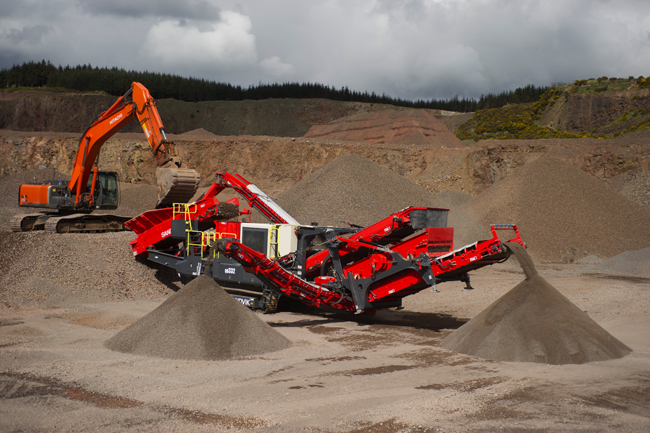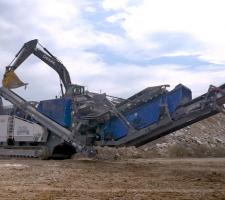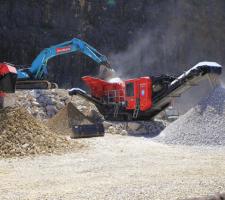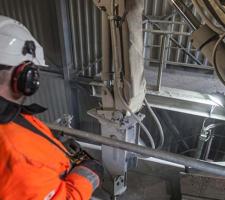
A leading global OEM has unveiled exciting new crushing and screening plant, while another prominent sector player is celebrating 60 years at the forefront of the world quarrying equipment sector. Guy Woodford reports.
The
Based on the highly successful QH331 mobile cone crusher, the QH332 DDHS also comes with the functionality of a double or single deck (utilising the top deck as a breaker deck) hanging screen in a fully detachable, standalone form. Detachable or attachable without the use of additional lifting equipment, the QH332 DDHS delivers multi-functionality as a one, two or three-way split screener, as well as being a highly productive and efficient cone crusher.
The Sandvik CH430 cone crusher is at the heart of the highly innovative model. It is equipped with a hydroset system which provides CSS adjustment at the touch of a button. The automatic setting regulation system not only optimises production, it also keeps track of liner wear, making it easy to plan liner changes and minimise interruptions in production. The CH430 cone has a choice of six concaves and three eccentric bushes providing a range of throws from 16-36mm, with these providing unrivalled flexibility regarding CSS ranges, production and material gradation.
Able to handle feed size of up to 185mm and capable of processing up to 220tonnes/hour of material in its larger bush setting, the QH332 DDHS’s novel design allows the model to be set-up in less than 30 minutes. The double deck, hanging screen enables the machine to produce two screened products and recirculate the oversize back into the feed conveyor. The oversize conveyor can be hydraulically rotated through 90° for stockpiling up to three products on the floor. The tail section can be raised hydraulically to give improved ground clearance for transport when loading or unloading.
The QH332 DDHS is said to have great durability as its chassis is made from heavy-duty ‘I’ beam. Its robust, hydraulically-positioned feed conveyor comes with optional wear resistant liners and hydraulic folding hopper extensions. An ‘up and over’ metal detector provides the ultimate in cone protection from tramp material.
Other model features include variable screen angle and hydraulic positioning to create a single deck HS using the top deck as a breaker deck without the need for a screen mesh removal. An onboard My Fleet system allows for live monitoring of the mobile cone crusher’s working hours, location and other factors. The QH332 DDHS’s battery and DEF tank have been relocated for easier access. The model requires no crusher backing behind the liners, which allows it to be operational immediately after a liner change. Variable crusher speeds allow for changes to be made to the gradation of the end products.
Further enhancing the QH332 DDHS’s crushing capability, a remote camera has been installed for viewing the crushing chamber, which enables the operator to set up and ensure a choke feed on the crusher from ground level.
Also launched at Hillhead 2018, the new QE342 from Sandvik Mobile Crushers & Screens is a heavy-duty scalper with a claimed class-leading open scalping area enabling it to deliver enormous rates of production. Its design and attributes mean that the production of even the most hard-wearing of materials is said to be facilitated through a wear-resistant steel apron feeder, with massive stockpiling capability and over-wide conveyors that maximise delivery.
Its new purpose-designed crusher style chassis has been developed specifically to accommodate the new more powerful and efficient engine power packs. Enhancing its versatility, the QE342’s wear resistant rigid hopper is compatible for two-way or three-way split configurations, as well as having the ability to interchange side conveyors, thereby demonstrating the ultimate flexibility of the unit. The screenbox, jack-up facility allows easier access to the bottom deck for maintenance and screen media changes.
As ease of operation is vital for enhanced use, the new QE342’s electrical control system incorporates several features to improve both the operational effectiveness and machine safety. The simple, easy to use system features a key switch, a mode selector switch (set-up, operation & tracking) and one global plant button to commence sequential automatic start-up & automatic shut-down of the plant during operating mode. A large visual display is also provided to enable the operator to view engine and plant status. Prestart warnings on all plant functions ensure that safety, as well as ease of operation, is always paramount. The QE342 also features two-speed tracks & radio control tracking as standard.
Sandvik Mobile Crushers & Screens has also launched a new hybrid option for its mobile screening model range. The option allows the end user to operate their machine either diesel-hydraulically or electric-hydraulically by plugging in to an external three-phase electric supply. The mobile screening unit can also be connected to a separate generator on an upstream crusher when working in a train. This allows the user to select the energy source which best suits them depending on location, local legislation and amenities nearby. The hybrid option is available on the QE341, QA441 and QA451 Doublescreen.
The company’s founder, John Finlay, laid the foundations for his business interests in 1953. With a background owning and operating his own aggregates, sand and gravel operations in Co. Tyrone, Northern Ireland, Finlay’s real passion was engineering.
In 1958 he called upon his engineering expertise to design and launch the world’s first hydraulic screener. It was in the same year that Finlay successfully registered a patent for the centre-placed single shaft screenbox technology that today is widely used across the industry.
It was from the invention of the single shaft screenbox that the brand ‘Finlay Hydrascreens’ was born. The Finlay Hydrascreens brand was acquired by Terex Corporation in 1999. Such was the reputation of the brand that Terex retained ‘Finlay’ and introduced today’s brand; Terex Finlay.
The values of integrity, customer satisfaction and innovation that John Finlay instilled in the company remain key pillars of the business today. To mark the company’s continued success and the landmark anniversary, Terex Finlay held a celebration event at the 2018 Hillhead Exhibition 26– 28 June 2018 in Buxton, England.
Speaking on behalf of the Finlay family, Stephen John Finlay, John Finlay’s eldest son, said this year’s trading landmark celebrations were bringing the Finlay family back to “our father John Finlay’s vision and inventiveness”. He continued: “He was the pioneer of screening and an inspiration to us all. He also invented the concrete block making machine and washing plant systems. We are proud that many of the major engineering companies in Northern Ireland have a direct link back to our dad’s designs, and they are still being used worldwide today. We would like to wish Terex Finlay every success in the future and congratulate them on this special anniversary.”
Paul O’Donnell, Terex Finlay global business line director, said of the company’s 60 years in engineering: “It’s an incredible milestone for our business and we are thrilled to be here, at the forefront of our industry. Our business has grown on the core values and beliefs of delivering world-class leading products that our customers can depend upon.
“We are not only celebrating 60 years in business, but 60 years of building and supplying innovative products across the globe. We wouldn’t be able to offer an unrivalled product range and service to our customers without the dedication and determination of our staff. I would also like to thank our loyal customers, wherever they are in the world, for trusting in Terex Finlay.”
Among Terex Finlay’s impressive Hillhead 2018 model line-up was the new I-120 impact crusher. Also showcased were the new J-1960 and J-1160 jaw crushers, while the NEW 883+ triple shaft screener was previewed in the working demonstration area. Terex Finlay also used the show to unveil a number of new conveying products in the form of TF-75L low level conveyor, TF-75H high level feeders and TR-75 radial conveyor.
In a recycling centre near Knoxville, Tennessee, in the United States, a MOBIREX MR 110 Zi EVO2 from
Whether this involves working on student halls of residence or highways – changing applications at a single location is no problem for the MR 110 Zi EVO2. In rapid time, the mobile impact crusher switches from rubble to asphalt and resumes work immediately.
With a total of 40,000 students, the University of Tennessee Knoxville (UTK) is one of the largest public universities in the United States. Many of the students live on the campus in one of the numerous halls of residence, one of which had to be demolished recently. The residual construction materials were transported to a recycling centre outside the city run by Crush LLC.
Challenges are presented during the crushing of concrete in the form of foreign material, such as iron reinforcement, wood, plastic and aluminium, which are embedded in the remaining concrete. In this regard, the adjustable magnet of the MR 110 Zi EVO2 provides an option for separating even large iron parts. Furthermore, the return conveyor that can be swivelled out can be used for regular clearing of undesired lightweight materials from the circuit. Both can be controlled conveniently by remote control, for example from the excavator.
The final product - around 200tonnes of which is produced an hour - is then used again in road construction. “A conscious decision was made in this application to omit prescreening because of the low share of fines in the feed material. However, with a prescreen it would have been possible to increase output by around 15%,” said Cale Cameron, operations manager at Crush LLC.
A further advantage of the MOBIREX EVO2 is its mobility. The recycling centre of Crush LLC is used to store rubble as well as asphalt from road construction and asphalt mixing plant material. In only a few minutes, the plant can be moved and put back into operation. Thanks to the compact design with integrated secondary screening unit, an additional screening plant does not have to be used. This makes operating in limited space conditions easier, and saves time and transport costs. The crushed asphalt is then added again to the material mixture in asphalt production.
This is not the first MOBIREX for Cameron. With an MR EVO1, he has already crushed one million tonnes of material; the EVO2 currently in use is also well on the way to reach this target. What particularly impresses him is the service life of the Mobirex and the fact that during all this time he has never experienced a broken rotor ledge. The standard series overload protection is responsible for this, which allows the impact toggles to draw back when uncrushable material enters the crushing chamber. “We have an EVO1 that has a million tonnes through it. We have the EVO2 that is approaching a million tonnes - and till today we have never broken a blow bar,” said Cameron.
A smooth and consistent material flow in the primary crushing process is critical to ensuring productivity and therefore profitability in the aggregates production process.
A spokesperson for the Finnish global quarrying equipment sector giant said: “A remotely-controlled rock breaker is by far the quickest way to deal with blockages and get the material flow running smoothly again. A rock breaker also allows operators to proactively address potentially problematic oversized or awkwardly shaped boulders before they even reach the primary crushing equipment.
“The primary crushing stage is a vital part of the aggregate production process. It is here where maintaining a smooth flow of materials helps to keep the rest of the production process on track. Breakdowns or other stoppages can be extremely costly in terms of both time and money, and have a knock-on effect on the later stages of the process like secondary and fine crushing. Blockages caused by single oversized rocks or coarse or uneven materials becoming jammed are the most frequent cause of stoppages.
“Dealing with a blockage involves far more than just removing the problematic rocks and then carrying on; equipment may have to be locked and powered down, and personnel may have to take time out to perform visual inspections – put simply, the entire production process can grind to a halt. To put this into perspective, in a plant processing 500tonnes of material/hour, a single period of downtime a day lasting between five and 10 minutes each time can translate into annual revenue losses of as much as €150,000, based on an end-product price of €7 per tonne.”
With a rock breaker installed in the primary crushing station, Metso says blockages and build-ups caused by oversized rocks getting stuck or coarse materials becoming jammed together can be resolved quickly, accurately, and safely. Importantly, the primary crushing process can continue with no break in production. A rock breaker, says Metso, also improves efficiency further along in the process because when the material flow from the primary station remains consistent, the following crushing stages produce better quality aggregates with a higher throughput.
The company spokesperson continued: “Metso rock breaker solutions are complete functional packages for rock breaking in the primary crushing stage of aggregate production, with every component engineered to meet the tough requirements of this demanding application area. They are optimised to work with Nordberg C Series jaw crushers to maximise the productivity of the whole primary crushing station.”


















